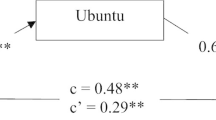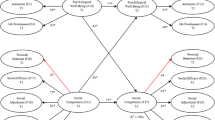Abstract
The authors develop and validate multidimensional and contextual profiles of competence among low-income, urban, middle adolescents (N = 560). The assessment of contextual competence was based on youth self-reports of involvement, performance, and relationship quality in the peer, school, athletic, employment, religious, and cultural contexts. A principal components analysis of these engagement indices revealed the six expected components with the addition of a component labeled “self-in-context.” To identify holistic, multidimensional profiles of contextual competence, scores along the seven domains were cluster analyzed. Nine clusters emerged, each representing a distinct constellation of youth experience. Profiles were associated with demographic variables and youth adjustment. Profiles reflecting high engagement in two or more contexts predicted higher self-esteem and lower depression. In contrast, profiles marked by high engagement in the contexts of athletics or employment predicted more serious delinquency. The authors discuss the implications of these findings for future research and intervention.
Similar content being viewed by others
References
Achenbach, T. M., & Edelbrock, C. (1987). Manual for the youth self-report and profile. Burlington, VT: University of Vermont Department of Psychiatry.
Adolescent Pathways Project. (1992). Involvement/participation scale: Psychometric development summary. New York: New York University.
Adolescent Pathways Project. (1994). Sports/athletic items and constructs: Psychometric development summary. New York: New York University.
Adolescent Pathways Project. (2002). Best friend engagement: Psychometric development summary. New York: New York University.
Barber, B. L., Eccles, J. S., & Stone, M. R. (2001). Whatever happened to the Jock, the Brain, and the Princess? Young adult pathways linked to adolescent activity involvement and social identity. Journal of Adolescent Research, 16(5), 429–455.
Bergman, L. R., & El-Khouri, B. M. (1998). SLEIPNER: A statistical package for pattern-oriented analyses. Stockholm, Sweden: Stockholm University.
Burton, L. M., Obeidallah, D., & Allison, K. W. (1996). Ethnographic insights on social context and adolescent development among inner-city African-American teens. In R. Jessor, A. Colby, & R. A. Shweder (Eds.) Ethnography and human development: Context and meaning in social inquiry. The John D. and Catherine T. MacAurthur Foundation series on mental health and development (pp. 395–418). Chicago, IL: University of Chicago Press.
Call, K. T., & Mortimer, J. T. (2002). Arenas of comfort in adolescence: A study of adjustment in context. Mahwah, NJ: Lawrence Erlbaum Associates.
Donahue, M. J., & Benson, P. L. (1995). Religion and the well-being of adolescents. Journal of Social Issues, 51(2), 145–160.
Dornbusch, S. M., Mont-Reynaud, R., Ritter, P. L., Chen, Z., & Steinberg, L. (1987). Stressful events and their correlates among adolescents of diverse backgrounds. In M. E. Colten, & S. Gore (Eds.) Adolescent Stress: Causes and Consequences. Hawthorne, NY: Aldine de Gruyter.
Dubois, D. L., Felner, R. D., Brand, S., Phillips, R. S. C., & Lease, A. M. (1996). Early adolescent self-esteem: A developmental-ecological framework and assessment strategy. Journal of Research on Adolescence, 6(4), 543–579.
Elliot, D. S., & Huizinga, D. (1983). Social class and delinquent behavior in a national youth panel. Criminology: An Interdisciplinary Journal, 21(2), 149–177.
Fuligni, A. J., Tseng, V., & Lam, M. (1999). Attitudes toward family obligations among American adolescents with Asian, Latin American, and European backgrounds. Child Development, 70(4), 1030–1044.
Gardner, H. (1993). Frames of mind: The theory of multiple intelligences. New York: Basic Books.
Harter, S. (1988). The self-perception profile for adolescents. Unpublished manuscript, University of Denver, CO.
Jahoda, M. (1958). Current concepts of positive mental health. New York: Basic Books, Inc.
Kimm, S. Y. S., Glynn, N. W., Kriska, A. M., Barton, B. A., Kronsberg, S. S., Daniels, S. R., Crawford, P. B., Sabry, Z. I., & Liu, K. (2002). Decline in physical activity in black girls and white girls during adolescence. The New England Journal of Medicine, 347(10), 709–715.
Larson, R. W. (2000). Toward a psychology of positive youth development. American Psychologist, 55(1), 170-183.
Loeber, R., Farrington, D. P., Stouthamer-Loeber, M., & Van Kammen, W. B. (1998). Antisocial behavior and mental health problems: Explanatory factors in childhood and adolescence. Mahwah, NJ: Erlbaum.
Luthar, S. S., Cicchetti, D., & Becker, B. (2000). The construct of resilience: A critical evaluation and guidelines for future work. Child Development, 71(3), 543–562.
Mahoney, J. L., & Bergman, L. R. (2002). Conceptual and methodological considerations in a developmental approach to the study of positive adaptation. Journal of Applied Developmental Psychology, 23(2), 195–217.
Masten, A. S., & Coatsworth, J. D. (1998). The development of competence in favorable and unfavorable environments. American Psychologist, 53(2), 205–220.
Moos, R. H., Cronkite, R. C., Billings, A. G., & Finney, J. W. (1984). Health and daily living form manual. Stanford, CA: Social Ecology Laboratory, Veterans Administration and Stanford University Medical Centers.
Mortimer, J. T., Finch, M., Shanahan, M., & Ryu, S. (1992). Adolescent work history and behavioral adjustment. Journal of Research on Adolescence, 2(1), 59–80.
O’Donnell, C. R., Tharp, R. G., & Wilson, K. (1993). Activity settings as the unit of analysis: A theoretical basis for community intervention and development. American Journal of Community Psychology, 21(4), 501–520.
Pedersen, S. (2004). Longitudinal patterns of out-of-school activity participation and trajectories of psychosocial development among low-income urban adolescents. Unpublished doctoral dissertation, New York University, New York.
Pedersen, S., & Seidman, E. (2005). Contexts and correlates of out-of-school activity participation among low-income urban adolescents. In J. L. Mahoney, J. Eccles, R. Larson (Eds) Organized activities as contexts of development: Extracurricular activities, after-school and community programs (pp. 85–109). Mahwah, NJ: Erlbaum.
Phinney, J. S. (1990). Ethnic identity in adolescents and adults: A review and integration. Psychological Bulletin, 108, 499-514.
Quinn, J. (1997). Positive effects of participation in youth organizations. In M. Rutter (Ed.), Psychosocial disturbances in young people: Challenges for prevention (pp. 274–304). Cambridge, UK: Cambridge University Press.
Rapkin, B. D., & Luke, D. A. (1993). Cluster analysis in community research: Epistemology and practice. American Journal of Community Psychology, 21, 247–277.
Rivera, A. C., Seidman, E., Pedersen, S., Karp, G., Allen, L., & Aber, J. L. (2004). Peer group empowerment, group composition, and well-being among urban early and middle adolescents. New York: New York University, manuscript in preparation.
Roberts, A., Seidman, E., Pedersen, S., Chesir-Teran, D., Allen, L., Aber, J. L., Duran, V., & Hsueh, J. (2000). Family and peer perceived transactions and self-esteem among urban early adolescents. Journal of Early Adolescence, 20(1), 68–92.
Seidman, E. (1991). Growing up the hard way: Pathways of urban adolescents. American Journal of Community Psychology, 19(2), 169–205.
Seidman, E., Chesir-Teran, D., Friedman, J. L., Yoshikawa, H., Allen, L., Roberts, A., & Aber, J. L. (1999). The risk and protective functions of perceived family and peer microsystems among urban adolescents in poverty. American Journal of Community Psychology, 27(2), 211–237.
Seidman, E., & Pedersen, S. (2003). Holistic contextual perspectives on risk, protection, and competency among urban adolescents. In S. S. Luthar (Ed.), Resilience and vulnerability: Adaption in the context of childhood adversities (pp. 318–342). Cambridge, UK: Cambridge University Press.
Seligman, M. E. P., & Csikszentmihalyi, M. (2000). Positive psychology: An introduction. American Psychologist, 55(1), 5–14.
Simmons, R. G., & Blyth, D. A. (1987). Moving into adolescence: The impact of pubertal change and school context. New York: Aldine.
Steele, C. M. (1997). A threat in the air: How stereotypes shape intellectual identity and performance. American Psychologist, 52(6), 613–629.
Steinberg, L., Fegley, S., & Dornbusch, S. M. (1993). Negative impact of part-time work on adolescent adjustment: Evidence from a longitudinal study. Developmental Psychology, 29(2), 171–180.
Sullivan, H. S. (1953). The interpersonal theory of psychology. New York: W.W. Norton & Company Inc.
Tseng, V., Chesir-Teran, D., Becker-Klein, R., Chan, M., Duran, V., Roberts, A., & Bardoliwalla, N. (2002). Promotion of social change: A conceptual framework. American Journal of Community Psychology, 30(3), 401–428.
U.S. Department of Health, Education and Welfare. (1975). National longitudinal study of the high school class of 1972: Student questionnaire and test results by sex, high school program, ethnic category, and father’s education. Washington, DC: Government Printing Office.
Wheeler, V. A., & Ladd, G. W. (1982). Assessment of children’s self-efficacy for social interactions with peers. Developmental Psychology, 18, 793–805.
Yoshikawa, H., & Seidman, E. (2000). Competence among urban adolescents in poverty: Multiple forms, contexts and developmental processes. In R. Montemayor, G. R. Adams, R. P. Gullotta, (Eds) Advances in adolescent development: Vol. 10. Cultural and economic diversity in adolescent development (pp. 9–42). Newbury Park, CA: Sage.
Author information
Authors and Affiliations
Rights and permissions
About this article
Cite this article
Pedersen, S., Seidman, E., Yoshikawa, H. et al. Contextual Competence: Multiple Manifestations Among Urban Adolescents. Am J Community Psychol 35, 65–82 (2005). https://doi.org/10.1007/s10464-005-1890-z
Issue Date:
DOI: https://doi.org/10.1007/s10464-005-1890-z




